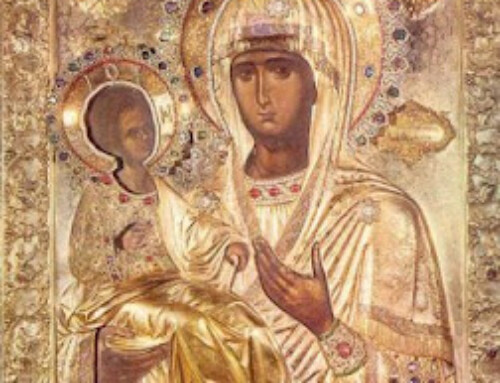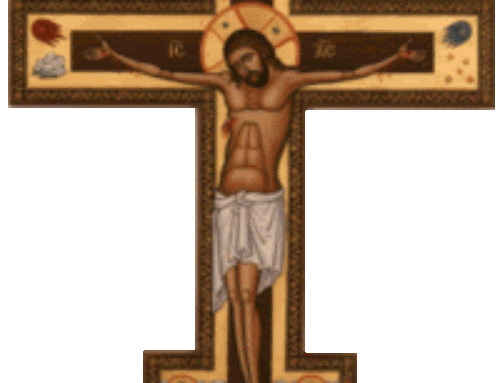 General Explanation of The Divine Liturgy
General Explanation of The Divine Liturgy
By Nicholas Cabasilas
Translated by: Rt. Rev. Athanasius E. Saliba
A resume of the first chapter “General Significance of Sacrifice” of the book Explanation of the Divine Liturgy
The essential function of the celebration of the Divine Liturgy is the transformation of the bread and wine into the body and blood of Christ. The purpose of the celebration is the sanctification of the faithful who receive (during the service) the remission of their sins and become inheritors of the kingdom of heaven. The believers prepare themselves for this Divine and mysterious act by prayers and reading of Holy Scripture.
God gives us all holy things gratis. However, he expects us to be worthy of receiving and keeping His Divine Gifts. He never allows the unworthy to participate in the act of sanctification.
This Divine procedure was revealed to us by Christ himself. He said, in the parable of the sower, “Behold the sower went out to sow. “He did not say that the sower went to plow the field, but to sow. This indicates that all the preparatory work must have been done before.
In order to benefit of the Divine gifts, we must be duly prepared. The form of this preparation is included in the service for our guidance. The reading, psalms, and prayers included in the Divine Liturgy purify us and render us worthy of receiving and keeping the sanctification.
This sanctifies us in two ways:
1. The prayers, Psalms, and reading of Holy Scripture guide us toward God, and cleanse us of our sins. The reading of Psalms brings us closer to God. It brings upon us the grace of his mercy. The prophet said: “Offer to God praise as your sacrifice and fulfill your vows to the Most High. Then call upon me in time of distress, I will rescue you, and you shall glorify me.”
The reading of Holy Scripture proclaims the bounty and love of God for us. It demonstrates to us, at the same time, the rigour of His justice. It instills in our mind the fear of God, and ignites in it our love for him. Furthermore, it awakens, in us, a great zeal to observe His commandments.
All this renders the soul of the priest and of the faithful more sublime, and more disposed to receive and keep the Holy gifts. This is the purpose of the Divine Liturgy.
We are sanctified also in another manner by the celebration of the Divine Liturgy. The prayers and rites which are said and performed during the service present before our eyes the life of Christ and His passion for us. The psalms, reading, and the acts performed by the priest during the Liturgy are an expression of the redemptive act of the Divine Economy. The first part of the service represents to us the beginning of the Divine act; the second part the development of that act; and the last part, the consequence thereof. Thus the witnesses of the Divine Liturgy have before them all the Divine things. The Consecration of the gifts commemorates the Death, Resurrection, and Ascension of Christ. The rites which precede the Consecration symbolize the events which happened before the Death of Christ, that is, His incarnation, His first appearance, and His perfect manifestation. The rites which follow the Consecration recall the promise of the Father, according to the words of Christ Himself, that is, the descent of the Holy Spirit upon the Apostles, and the Conversion of nations by the latter.
The entire mystery is like a unique representation of one body fashioned by the Saviour. It represents the different members of this body from the beginning to the end, according to their order, and their harmony. Therefore, the preliminary psalms or hymns, with all that is said and done during the preparation of the prothesis, symbolize the first period of the Divine redemptive act. The reading of Scripture and the chanting of hymns thereafter symbolizes the following period.
2. The belief that there is another benefit derived from reading and chanting-for they were introduced to make us virtuous, and to obtain favor before God-does not prevent that the same rites could, as a whole, guide us toward a virtuous life, and, at the same time, express the redemptive Divine act. The vestments fulfill their function as cloths by covering the body. However, they signify, at the same time, the profession or the condition and dignity of those who wear them. The same is true of the content of the liturgical service. Because it includes inspired formulae, and praises to God; and because it preaches virtue, the Divine Scripture sanctifies those who read it and chant it. On the other hand, the choice of Holy Scripture, and the order according to which it is arranged have another meaning. They signify the arrival of Christ and His redemptive act.
The gestures made during the service, play the same role as the chants and readings. Each one has an immediate meaning, but it symbolizes, at the same time, something of the work of Christ, His actions, or His suffering. We have an example of this dual significance in the little entrance, then the great entrance. They both represent the appearance and manifestation of Christ. The first represents Christ’s appearance in the beginning of his mission, whereas the second represents His full and perfect manifestation.
All the rites performed during the Divine Liturgy are related to the act of salvation. Their purpose is to place before our eyes the manifestation of the Divine Economy in order to sanctify our souls, and thereby render us worthy of the Holy Gifts. With perpetual contemplation, the redemptive act will perfect the soul of the faithful, and render it more divine in the same manner in which it uplifted the world when it was realized for the first time. However, it would be of no value to man if it were not the object of faith and contemplation. For this reason it was preached by Christ and the Apostles. Christ performed many miracles in order to strengthen the faith of His followers. The redemptive act cannot fulfill its role, and save man if it were-after being realized-ignored by those who must be saved by it. When the redemptive act was preached for the first time, it created, in the soul of those who did not know it, the veneration for Christ, the faith and love which did not exist before. Today contemplated with fervor by those who already possess the faith and other Christian characteristics, it conserves, renews, and increases them. It renders the faithful more firm in faith, more generous in piety and in love.
These are the sentiments with which we must approach the Holy Gifts; and without which it would be impious to even glance at them.
The arrangement of the Divine Liturgy allows us to see the extreme poverty of the richest. The descent on earth of the omnipresent, the suffering of the all-powerful. It allows us to hear how much He was hated; and how much He loved; how much He was humiliated, how much He suffered; and how much He accomplished in order to prepare us for this Holy table. Thus we admire the Divine act of salvation and after being overwhelmed by the abundance of the Divine mercy, we worship Him who had compassion on us and saved us at such a price. We offer to Him our soul and our life asking Him to burn our heart by the fire of His love. After being prepared, in this manner, we can, with confidence, approach the blazing and Divine mysteries.
To acquire, in fact, this disposition, we must not only learn about Christ’s teaching, but we must also fix our thoughts on these Divine truths and contemplate them. Furthermore, we must ban from our mind every strange idea. If we really want, in view of this sanctification, to acquire the disposition of mind aforesaid, we must act with due respect for the Holy mysteries from the beginning to the end of the celebration of the Divine Liturgy. If we do not consider carefully these things during the celebration; if we occupy our mind with other things; we will not derive any benefit. For our disposition corresponds with our thoughts, and our sentiments are the consequence of the thoughts we entertain.
This is the purpose of symbolism in the Divine Liturgy. It is not expressed entirely by words, but, it is enacted for our benefit throughout the service. The purpose of such arrangement is to act in an easier manner on our soul. The purpose is not to offer us a simple vision, but to create also a sentiment in our heart. This continues throughout the Divine Liturgy to hold our attention, and to prevent our thoughts from turning to other objects. After being thus prepared we can partake of the Divine Gifts. We add, by partaking of the Body and blood of Christ, sanctification to sanctification, that is, the sanctification of the Holy Gifts to the sanctification which we acquire by an effective participation in the celebration of the Divine Liturgy.
We are, thus, transformed from “Glory to Glory”, this is, from the glory of repentance and contemplation to the glory of sonship through communion with the Body and blood of the Son of God.
The Word/September, 1962; pp. 6,23





